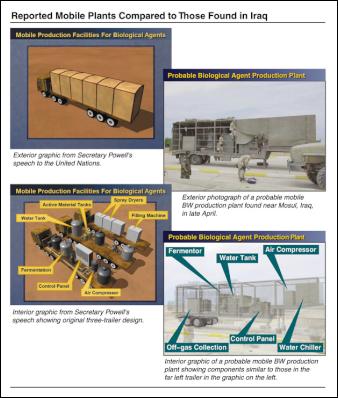William Rivers Pitt: Winnebagos of Death
Winnebagos of Death
By William Rivers Pitt
t r u t h o u t | Perspective
From: http://www.truthout.org/docs_2005/111005I.shtml
Thursday 10 November 2005
I've been digging into one of the justifications for invading Iraq proffered by the Bush crew over the last two years. Bear with me, as this gets into chemistry.
Let's take a look at the Winnebagos of Death. You will remember these as the mobile biological weapons laboratories in Iraq so dramatically described by Colin Powell before the UN in February of 2003. "We have firsthand descriptions," said Powell, "of biological weapons factories on wheels and on rails. The trucks and train cars are easily moved and are designed to evade detection by inspectors. In a matter of months, they can produce a quantity of biological poison equal to the entire amount that Iraq claimed to have produced in the years prior to the Gulf War. Ladies and gentlemen, these are sophisticated facilities. For example, they can produce anthrax and botulism toxin."
Scary stuff. Too bad it wasn't true.
The basis for these claims came from a CIA/DIA report that was made public in May of 2003. Since its release, and Powell's performance before the UN, the report has been shot to pieces.

Click for big version
In June of 2003, the UK Guardian reported, "An official British investigation into two trailers found in northern Iraq has concluded they are not mobile germ warfare labs, as was claimed by Tony Blair and President George Bush, but were for the production of hydrogen to fill artillery balloons, as the Iraqis have continued to insist. The revelation that the mobile labs were to produce hydrogen for artillery balloons will also cause discomfort for the British authorities because the Iraqi army's original system was sold to it by the British company, Marconi Command & Control."
The thing is, despite the fact that Powell publicly distanced himself from his now-humiliating UN display, and despite several reports in the British press describing in detail what these mobile facilities were actually used for, you can still hear Bush defenders talk about them in the American press to defend the invasion. The story behind the CIA/DIA report and its massive flaws has not been widely reported over here. Yet it was one of several key threats thrown at the American people to justify a war.
"They can produce enough dry biological agent in a single month," said Powell in February of 2003, "to kill thousands upon thousands of people. And dry agent of this type is the most lethal form for human beings." In other words, bring me the plastic sheeting and duct tape, because we're all going to die.
I spoke at length with Brad Spencer, Ph.D, an expert in this area, who took a great deal of time to explain the flaws in the CIA/DIA report, and the flaws in the subsequent scaremongering that came out of the White House.
"Bush was relying on the CIA/DIA white paper that purported to conclude that the trailers found in Iraq were mobile biological culture systems," said Spencer. "That's the only apparent 'hard' evidence he ever cited, and it was false from the start. There are obvious fabrications in the white paper, fabrications that fly in the face of science. It's garbage. It's a lie. It is the most easily proved of all the lies yet it is still allowed to stand. I have made hydrogen using the same reaction as was used by the Iraqis on those trailers. I could and did determine, from the information in the white paper itself, that the trailers were for hydrogen manufacture. How much more blatant and obvious do you need a lie to be before you expose it as such?"
As I have never been an ace in the science department, I asked Dr. Spencer to describe in detail the problems with the report. "To start with," he said, "I've known since the 1970s, when I was in graduate school, that the reaction used on the trailers generates a lot of heat along with the hydrogen and that the cooling unit is a necessary part of the system. Anybody that runs the reaction will discover that fact. The fable the white paper weaves about the Iraqis discovering that the heat of summer interfered with WMD culture and adding the unit (the white paper says it was added 'because the drawings by Powell showed no cooling unit and the difference had to be explained') is utter nonsense."
"In reality," said Spencer, "any competently designed biological culture system, mobile or otherwise, would have to have not merely a cooling unit but a full temperature control system for the culture vessel. That was utterly lacking in the drawings shown by Powell at the UN and apparently utterly lacking in the expensive mock-up of such trailers constructed by the US (David Kay was on that team) before the war. That it is only a cooling unit and not a temperature control system is actually strong evidence that the trailers are not for biological WMD culture - exactly opposite to the white paper claim but in accord with the requirements of both kinds of system."
"The reaction used on the trailer to make hydrogen (aluminum metal plus sodium hydroxide plus water)," said Spencer, "has been used for that purpose since at least the early part of the 20th century (there's at least one US patent from that date for a system that uses that reaction) and was also mentioned in a 1960s or 1970s National Geographic article, which is where I learned of it. I was in graduate school at the time and tried the reaction at home, learning in the process that the heat was produced: I ended up more than once with a bottle of boiling lye solution with a balloon on the neck of the bottle. The trailers would surely have to produce hydrogen at something like 100 to 1000 times the volume I produced, with corresponding increase in the amount of heat evolved. It would be essential to remove that heat to avoid damage to valves and pumps from boiling lye."
"The culture vessel also would not be the very obvious pressure vessel seen in the photograph in the white paper," Spencer continued. "The trailer had no shocks, no springs. It would be idiotic to do a biological culture under pressure on such a system: the stresses involved in moving the trailer would cause leaks and a biological WMD culture system under pressure would spew biological WMD out from any leak. Nor is there likely to be an advantage to doing the culture under pressure: pressure is used to enhance the yields of chemical reactions in the gas phase where the reactant gases combine to form a product gas. When the number of molecules of product gas is less than the number of molecules of reactant gas, for example in the manufacture of polyethylene, increased pressure does increase yield."
"The compressor and gas bottles are needed to compress and store the hydrogen," said Spencer, "as the white paper essentially admits. The fable about a tell-tale off-gas that had to be compressed and stored is fantastically ridiculous. The UN inspectors weren't monitoring the atmosphere for any such by-product, the white paper identifies no such by-product, biological WMD, or biological WMD culture process. If there were a tell-tale gaseous by-product, simple combustion would destroy it, just as drawing crankcase vapors into the intake manifold of a car destroys those vapors. It isn't biological WMD processes that create indestructible tell-tale by-products, it's nuclear ones. It's a fable spun by a non-technical person whose main skill appears to be twisting facts to fit a story. There's not a shred of evidence that the compressor was for the purpose of capturing any by-product: it's a story from the imagination of someone with low technical skills - a person of greater skill would recognize how fantastic the story is."
"The white paper claims that the fact the trailers had recently been repainted was evidence of efforts to conceal use of the trailers for WMD culture," said Spencer. "If there was such evidence, the paint would cover and preserve the evidence. Scratch it off and do an analysis. That, too, is glossed over. It's a cooked story, created by a non-technical person. It's indefensible. There's literally no hard evidence to back up the claim that the trailers were for WMD culture, no evidence for the cooling unit fable, no evidence for the compressor and gas bottle fable."
"Not only did the CIA issue a very unusual report to the people, something very rare for the CIA to do," concluded Spencer, "the report contains completely unsupported claims. Who can possibly maintain that the CIA did that on their own, with no pressure applied? Who can believe that, unprodded, the CIA decided to issue a white paper containing wild speculations? When the CIA subsequently produced the Duelfer report all such fantasies disappeared, and the Duelfer report correctly concluded that the trailers were for hydrogen production. It's the same CIA, the same analysts, nearly the same evidence. Something made them behave strangely in 2003, right when the administration was desperate for some proof of Iraqi WMD activity. It's also worth noting who it was in the administration that relied on the white paper the longest, continuing to do so even after it was revealed that 'Curveball' was an unreliable source and after Colin Powell had disavowed his own UN presentation."
I got a funny note from a truthout reader the other day that covers a similar situation. The reader observed something amusing about Ibn al-Shaykh al-Libi, the so-called "source" who claimed that Iraq was hosting al Qaeda terrorists. His information was used by Bush, Cheney, Rumsfeld, Rice, Powell and the rest of them to justify the invasion, even though the Defense Intelligence Agency warned them that al-Libi was lying through his teeth. It turns out, in fact, that al-Libi was indeed crafting extravagant lies about al Qaeda in Iraq out of whole cloth, and eventually recanted all of his testimony in 2004.
So here's the funny part the truthout reader came up with. If you sound out the name Ibn al-Shaykh al-Libi in just the right way, it sounds an awful lot like "I've been a shaky alibi." Indeed, he was. It seems we can lump Mr. Shaky Alibi in with this report on the Winnebagos of Death. You've got to love serendipity.
William Rivers Pitt is a New York Times and internationally bestselling author of two books: War on Iraq: What Team Bush Doesn't Want You to Know and The Greatest Sedition Is Silence.


 Gordon Campbell: On The Government’s Latest Ferries Scam
Gordon Campbell: On The Government’s Latest Ferries Scam Peter Dunne: Dunne's Weekly - While We're Breaking Up Monoliths, What About MBIE?
Peter Dunne: Dunne's Weekly - While We're Breaking Up Monoliths, What About MBIE? Adrian Maidment: Supermarket Signs
Adrian Maidment: Supermarket Signs Ian Powell: Revisiting Universalism
Ian Powell: Revisiting Universalism Martin LeFevre - Meditations: In A Global Society, There Is No Such Thing As “National Security”
Martin LeFevre - Meditations: In A Global Society, There Is No Such Thing As “National Security” Binoy Kampmark: Secrecy And Virtue Signalling - Another View Of Signalgate
Binoy Kampmark: Secrecy And Virtue Signalling - Another View Of Signalgate